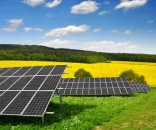India needs mix of green & traditional power sources: J.P. Chalasani, Reliance Power
Recently, Reliance Power commissioned India's largest solar power plant in Pokharan, close to the western
periphery of Rajasthan. We felt justifiably proud.
It has displaced over 70,000 metric tonnes of carbon dioxide emissions annually, which is roughly the
equivalent of taking 25,000 cars off the road. And yet, for me, the thought that a 40 MW solar plant
represented no more than a drop in the ocean was inescapable.
Today, India finds itself at the crossroads, grappling with the energy security-sustainable development
conundrum. So, can rapid economic growth and sustainable, more inclusive, development be achieved in tandem?
As a concerned and responsible organisation, we pause and ponder once again about what we can do to recalibrate
and escalate efforts towards ensuring that we can answer that question in the affirmative.
That over one-third of India's rural population has no access to electricity must surely be a sobering thought
for those of us who feel proud that we are a fast emerging global economy.
India needs to substantially bridge the gap between demand and supply of electricity for sustained economic
growth and to kindle hope in the lives of its people. To bring light into the lives of those many people we
need all sources of power that we can get access to.
I believe diversified fuel sources and new technologies will, in the years ahead, come to India's rescue and
help us strike a balance between our growth imperatives and sustainability. To begin with, in the energy mix in
India, as in the case of other fast growing economies, coal continues, and will continue to, play a crucial
role.
In India, coal accounts for more than 70 per cent of the country's electricity generation. Of the 54,000
megawatts of power capacity added between 2007 and 2012 in India, over 70 per cent was coal-based. While
coal-fired power generation is perceived as a major factor in carbon dioxide emissions leading to global
warming, the use of advanced technology in recent times is rapidly changing that scenario.
https://economictimes.indiatimes.com/news/news-by-industry/energy/power/india-needs-mix-of-green-traditional-pow
er-sources-j-p-chalasani-reliance-power/articleshow/13833024.cms













 Advertise
Advertise











